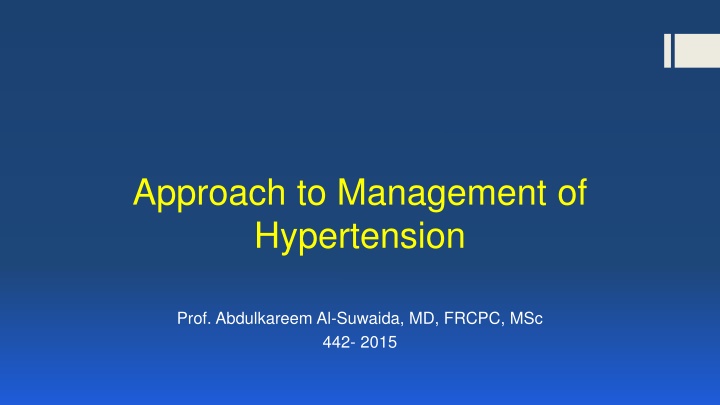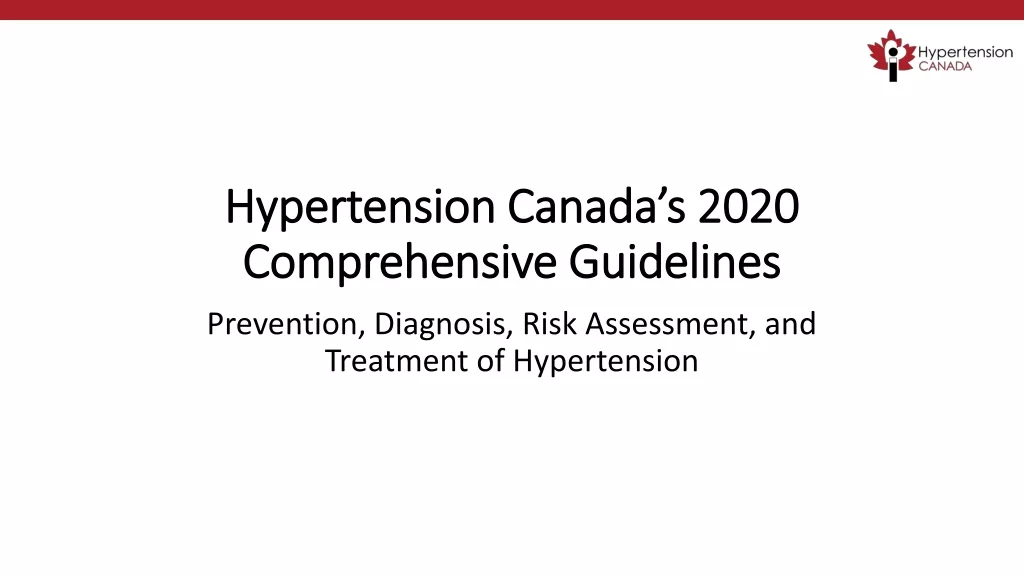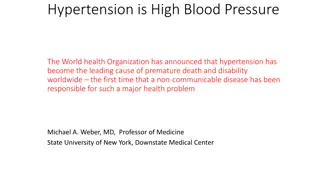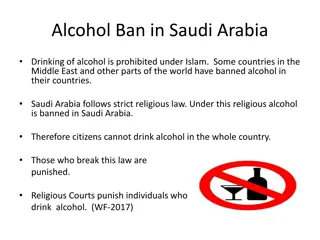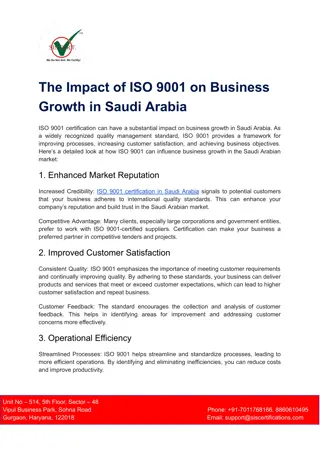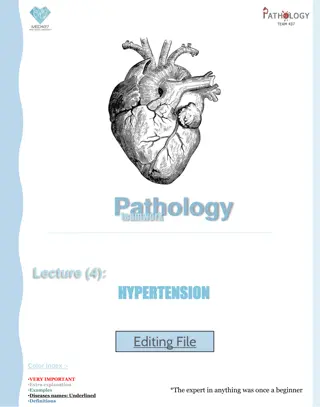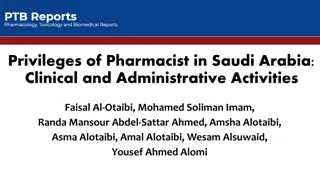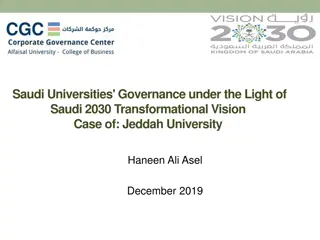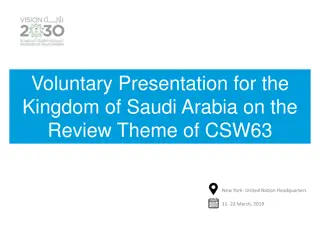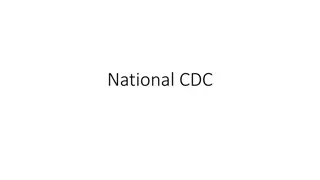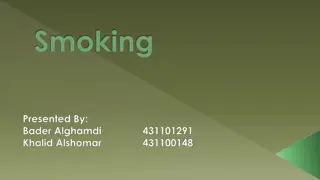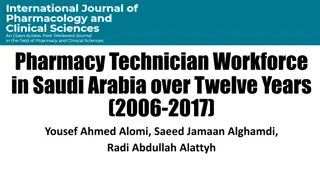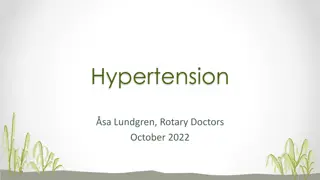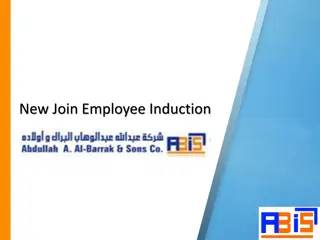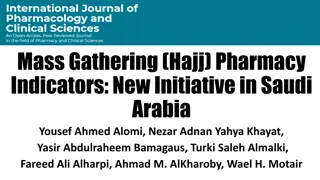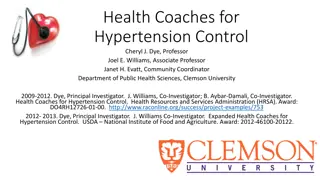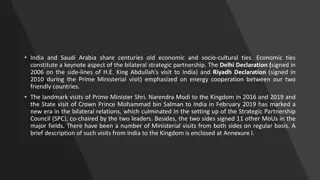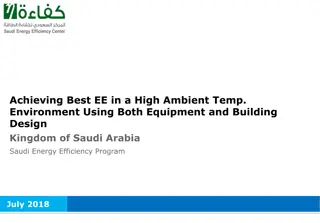Management of Hypertension in Saudi Arabia
Prevalence of hypertension in Saudi Arabia is a significant health concern, with a considerable number of individuals affected. This article delves into the diagnosis, evaluation, and management of hypertension, highlighting the importance of lifestyle modifications and drug therapy. Case studies and criteria for hypertension diagnosis are also discussed.
Download Presentation

Please find below an Image/Link to download the presentation.
The content on the website is provided AS IS for your information and personal use only. It may not be sold, licensed, or shared on other websites without obtaining consent from the author.If you encounter any issues during the download, it is possible that the publisher has removed the file from their server.
You are allowed to download the files provided on this website for personal or commercial use, subject to the condition that they are used lawfully. All files are the property of their respective owners.
The content on the website is provided AS IS for your information and personal use only. It may not be sold, licensed, or shared on other websites without obtaining consent from the author.
E N D
Presentation Transcript
Approach to Management of Hypertension Prof. Abdulkareem Al-Suwaida, MD, FRCPC, MSc 442- 2015
Outline of The Lecture Prevalence of HTN in KSA Diagnosis of Hypertension Evaluation and Risk Assessment Screening for Secondary Causes of HTN Management Life style modifications Drug therapy
PREVELANCE OF HYPERTENSION 25.5% among individuals 15 64 years old in Saudi Arabia 40.6% of Saudis, or 5,222,051, had borderline hypertension Hypertension was the leading risk factor for death in the Kingdom of Saudi Arabia. Hypertension accounted for about 24% of total deaths from cardiovascular and circulatory diseases. * Institute for Health Metrics and Evaluation (IHME), GBD arrow Diagram, Saudi Arabia. Risk of deaths.1990 2010, IHME, University of Washington, Seattle, Wash, USA, 2013 * The Global Burden of Disease 2010 (GBD 2010)
Percent distribution of diagnosis and treatment status among hypertensive Saudi aged 15 years or older, 2013. 5.4% 16.6% 57.8% 20.2% Undiagnosed Uncontrolled Controlled Diagnosed, untreated
Case Study Mr. M is a 48-year-old teacher who sees you occasionally for upper respiratory tract infections. He has no significant past medical history is taking no medicines has no known allergies is a regular smoker. Father has hypertension & IHD. You noticed that his Pulse rate 78, regular blood pressure (BP) 148/94 mmHg. Ht 170 cm and weight 98 Kg. Does Mr. M have hypertension?
Criteria for the diagnosis of hypertension and recommendations for follow-up Hypertension can be diagnosed using one of the following three strategies: Ambulatory blood pressure monitoring (ABPM) Home blood pressure monitoring Office-based blood pressure measurements
Criteria for the diagnosis of hypertension and recommendations for follow-up Hypertension can be diagnosed using one of the following three strategies: Ambulatory blood pressure monitoring (ABPM) a 24-hour average BP greater than or equal to 130/80 mmHg
Criteria for the diagnosis of hypertension and recommendations for follow-up Hypertension can be diagnosed using one of the following three strategies: Home blood pressure monitoring at least 12 to 14 measurements; morning and evening measurements taken, over a period of one week; BP greater than or equal to 135/85 mmHg.
Criteria for the diagnosis of hypertension and recommendations for follow-up Hypertension can be diagnosed using one of the following three strategies: Office-based blood pressure measurements High BP readings in at least three visits, spaced over a period of one week or more. One reading is enough if hypertensive emergency.
Hypertension Definitions Prehypertension systolic 120 to 139 mmHg or diastolic 80 to 89 mmHg. Stage 1 hypertension - clinic readings 140/90 mm Hg and ABPM/HBPM 135/85 mm Hg. Stage 2 hypertension - clinic readings 160/100 mm Hg and ABPM/HBPM 150/95 mm Hg.
His average ABPM readings is 150/100 mm Hg Which of the following is the most accurate clinical assessment of his present situation? A. Pre-Hypertension B. White coat hypertension C. Stage 1 hypertension D. Stage 2 hypertension E. Hypertensive Emergency
Evaluation of patients with documented HTN: Look for secondary causes of high BP. Identify CV risk factors or concomitant disorders. Assess for target organ damage and CVD.
Causes of Secondary Hypertension Chronic kidney disease Primary aldosteronism Renovascular disease Sleep apnea Drug-induced or related causes Steroid therapy and Cushing s syndrome Pheochromocytoma Coarctation of the aorta Thyroid or parathyroid disease
Assessment of the overall cardiovascular risk and Search for target organ damage Cerebrovascular disease transient ischemic attacks ischemic or hemorrhagic stroke vascular dementia Hypertensive retinopathy Left ventricular dysfunction Left ventricular hypertrophy Coronary artery disease myocardial infarction angina pectoris congestive heart failure Chronic kidney disease hypertensive nephropathy (GFR < 60 ml/min/1.73 m2) albuminuria Peripheral artery disease intermittent claudication ankle brachial index < 0.9
Routine Laboratory Tests Preliminary Investigations of patients with hypertension 1. Urinalysis 2. Blood chemistry (potassium, sodium and creatinine) 3. Fasting glucose 4. Fasting lipid profile 5. Standard 12-leads ECG 6. Optional tests a. Urinary albumin excretion or albumin/creatinine ratio b. Limited Echo for LVH
Case Study (continue) Laboratory Findings: Urine: No Protein, No RBC & No WBC EKG: LVH Na 140 K 3.9 FBS 7.5 mmol/l Creatinine 105 umol/l Cholesterol 6.9 (LDL 5.4, HDL 1.1) Triglycerides 2.8 Hb 18.1
Diagnosis of Mr. M Stage 1 HTN, Obese with Diabetes and Hyperlipidemia.
Benefits of Lowering BP Average Percent Reduction Stroke incidence 35 40% Myocardial infarction 20 25% Heart failure 50%
How low should you go? What drugs and doses should you use? How many medications will you need?
? Which of the following is most appropriate BP goal in this patient? a. <125/75 b. <130/80 c. <140/90 d. <150/100
Evidence Based Goals 2015 < 140/90 for < 60 Year-old < 150/90 for >=60 Year-old
Goals of therapy in JNC8 & Euro Guidelines Maximum reduction in long-term total risk of cardiovascular morbidity and mortality: Smoking Life style modification Lipid Diabetes Blood pressure target
Effect of Long-Term Modest Reductions in CV Risk Factors 45% 10% 10% + = Reduction in BP Reduction in Total-C Reduction in CVD Emberson et al. Eur Heart J. 2004;25:484-491.
Does Mr.M need BP-lowering medicine?
? According to Guidelines, This patient should be treated by ... a. Pharmacological treatment only b. Lifestyle modification only c. Pharmacological treatment & Lifestyle modification d. Just Stop Smoking
BLOOD PRESSURE (Repeated Readings) Stage 1 Stage 2 OD, CKD stage 3 or DM Life style + Drug Treatment Life Style
? Which of the following is the most appropriate recommendation to start his antihypertensive regimen? a. Amlodipine 5 mg daily b. Irbesartan 150 mg daily c. Hydrochlorothiazide 12.5 mg daily d. Furosamide 20 mg daily
Treatment of Adults with Systolic/Diastolic Hypertension without Other Compelling Indications TARGET <140/90 mmHg Lifestyle modification therapy Long- acting CCB Beta- blocker* Thiazide ACEI ARB A combination of 2 first line drugs may be considered as initial therapy if the blood pressure is >20 mmHg systolic or >10 mmHg diastolic above target *BBs are not indicated as first line therapy for age 60 and above ACEI, ARB and direct renin inhibitors are contraindicated in pregnancy and caution is required in prescribing to women of child bearing potential
Impact of Lifestyle Therapies on Blood Pressure in Hypertensive Adults Intervention Intervention SBP/DBP -1800 mg/day sodium Hypertensive Reduce sodium intake -5.1 / -2.7 Weight loss per kg lost -1.1 / -0.9 Aerobic exercise 120-150 min/week -4.9 / -3.7 DASH diet Hypertensive Dietary patterns -11.4 / -5.5 Padwal R et al. CMAJ 2005;173;(7);749-751
Lifestyle Therapies in Adults with Hypertension: Summary Intervention Target Reduce foods with added sodium Weight loss Alcohol avoidance Physical activity Dietary patterns < 2300 mg /day BMI <25 kg/m2 30-60 minutes 4-7 days/week DASH diet Smoking cessation Smoke free environment Men <102 cm Women<88 cm Waist circumference
Hypertension with Other Compelling Indications Indications Recent MI Preferred anti HTN Beta-blocker and ACEI or ARB Stable angina ACE, B-blocker Long-acting CCB Systolic dysfunction ACEI and Diuretics Stroke or TIA ACEI / diuretic combination LVH ACEI, ARB, CCB, Thiazide DM ACE or ARB
Hypertensive Urgency Severe elevation of blood pressure Generally DBP >115-130 No progressive end organ damage
Hypertensive Emergency Severe elevation in blood pressure in the presence of acute or ongoing end-organ damage.
Cardiac Emergencies Acute CHF Acute coronary insufficiency Aortic dissection
Hypertensive Emergency Key Points CNS Emergencies Hypertensive encephalopathy Intracerebral or subarachnoidal hemorrhage Thrombotic brain infarction with severe HTN
Hypertensive Emergency Key Points Renal Emergencies Rapidly progressive renal failure
Fundoscopy/ Neuro Hemorrhages Exudates Papillodema
Urgency vs. Emergency Distinguishing between hypertensive emergency and urgency is a crucial step in appropriate management
Urgency vs. Emergency Urgency No need to acutely lower blood pressure May be harmful to rapidly lower blood pressure Death not imminent Emergency Immediate control of BP essential Irreversible end organ damage or death within hours
HTN Urgencies: Goals of Therapy No proven benefit of rapid BP reduction in asymptomatic patients Goal BP <160/110 mm Hg over several hours, oral therapy Initial BP fall less than 25% in first six hours can be managed using oral antihypertensive agents in an outpatient or same-day observational setting Ensure follow-up: Long-term management
HTN Urgencies: Therapy The calcium channel blocker nicardipine, 30 mg, q 8 hours until the target BP Labetolol, the starting dose is 200 mg orally, which can be repeated every 3 to 4 hours Clonidine is a central sympatholytic a 0.1 to 0.2 mg loading dose followed by 0.05 to 0.1 mg every hour until target BP is achieved (Max 0.7 mg).
Hypertensive Emergency ICU with close monitoring IV and Short acting medications Avoid sublingual or IM Arterial line Prevent end organ damage NOT normalize BP Exceptions??
Goals of Treatment Within 1-2 hrs Lower MAP 20-25% CONTROLLED IV titratable meds
Complications for rapid BP Reduction in Severe Hypertension Widening Neurologic Deficits Retinal ischemia and Blindness Acute MI Deteriorating renal function
